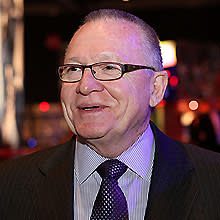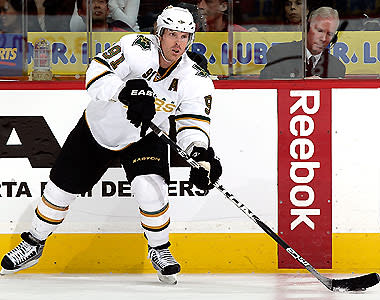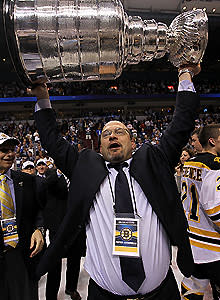NHL free agency: It's buyer beware in 2011
Carolina Hurricanes general manager Jim Rutherford was leaning against a railing at the NHL draft Saturday when a reporter asked where he stood in relation to the floor. Rutherford looked down and laughed. But maybe he should have looked up.
By "floor," the reporter was referring to the salary floor or minimum payroll level – set at $48.3 million for 2011-12, which is above the current commitments of the Hurricanes and several other teams.
"Do you say, 'Oh, my god, I've got to spend …' " a reporter started to ask.
"More money than I can afford?" Rutherford finished. "Yeah."
Such is the economics of the NHL as free agency opens Friday. What's down is up, and buyers had better beware even more than usual of making mistakes that could haunt them for years to come.
In the Wild West days before the salary cap, the big-money teams were the ones who caused inflation. They splurged on free agents and pulled up the value of other contracts along with them. Their risk was mostly financial. If things didn't work out, they could buy their way out of mistakes by signing other players.
But when the salary cap was introduced after the 2004-05 lockout, it created a new set of dynamics that led us to where we are today. The list of unrestricted free agents starts with one marquee player, center Brad Richards(notes), and then drops off dramatically. Teams are poised to throw a lot of money at the remaining players, at least partly so they can reach the floor, driving up prices from below.
"They're generally higher in the unrestricted market, but I think there will even be an added premium because teams have to spend," Boston Bruins GM Peter Chiarelli said. "Then all the other [comparables] follow in line, and that's why I'm a little cautious going into this market. There's not the supply that there normally is, and I think the demand is greater because of the cap floor."
The risk isn't just financial for top-spending teams. The risk is to roster flexibility for this season and beyond. Screw up, and you cost yourself cap space. Though the cap has risen steadily and has been set at $64.3 million for 2011-12, the collective bargaining agreement expires in September 2012. The NHL and NHL Players' Association have to negotiate a new CBA.
"The cap is high," Chiarelli said. "The cap is certainly going to come down in some shape or form. So, generally speaking, I'm wary of the market, where I think it might be going. … At the end of the day the parties will decide where the CBA is. But I can't see it being where it's at now."
Not when so many teams are struggling to reach a floor that is more than $9 million above the original cap. Both are tied to league-wide revenues, which have been boosted to record levels by the success of the strongest teams and the rise of the Canadian collar.
"It makes it harder for us to run a successful business," Rutherford said. "And then not only harder … I mean, even if we spend to the floor, we're still $16 million behind the other teams, which gives us a disadvantage there."
A main reason why the supply of free agents is so low is that the CBA signed in 2005 reduced the age for unrestricted free agency from 31 to 27. Not wanting to lose players in their primes, teams started locking up core pieces for long terms.
"Everybody thought that, if you're happy with what you've got, get them signed up and keep your own players," Nashville Predators GM David Poile said. "That's not 100 percent, but most teams are acting like that."
As a result, few top-tier players have been making it to unrestricted free agency, so teams have had to resort to trades to shake up their rosters or acquire cornerstones outside of the draft. GMs have become more comfortable moving younger players and bigger contracts.
Erik Johnson(notes) (22), Kevin Shattenkirk(notes) (22), Chris Stewart(notes) (23), James Neal(notes) (23), Matt Niskanen(notes) (24) and Alex Goligoski(notes) (25) were among those who moved before the trade deadline this year. Devin Setoguchi(notes) (24), Brent Burns(notes) (26), Jeff Carter(notes) (26) and Mike Richards(notes) (26) were among those who moved before or during the draft.
Buffalo Sabres GM Darcy Regier expects trade talk to pick up again after the first wave of free agency.
"I think we'll go through the unrestricted market, and then teams, if they weren't able to fill the needs, I think you'll see a secondary market and you'll see a trading market as well," Regier said.
Dallas Stars GM Joe Nieuwendyk wanted to lock up Richards long term, too, but he couldn't because of the team's uncertain ownership situation. He wanted to trade Richards' rights ahead of free agency, but Richards refused to waive his no-movement clause.
Richards couldn't be in a better position as the only premier unrestricted free agent available Friday and wants to weigh all of his options, which should include strong bids by the New York Rangers, Toronto Maple Leafs, the Sabres and several others.
"The is the first time he's experienced this in his career, so he welcomes that part," said Pat Morris, Richards' agent. "But also at the same time, there potentially could be so many good choices, and you only get to pick one, and that can boggle your mind at times. He's looking forward with an open mind to how this is going to go."
But even Richards, whose resume includes a Stanley Cup and a Conn Smythe Trophy as the playoffs' most valuable player, comes with risks. He's 31 and has a concussion history. Many are doubtful he'll be able to live up to the length of a big long-term deal.
And after Richards?
"The market for No. 1 centers is really, really scarce," said Columbus Blue Jackets GM Scott Howson, who acquired Carter from the Flyers.
The market for anything is thin and getting thinner, as teams have gone insane trying to get ahead of the insanity.
Some have thrown big money at their own players, like the Washington Capitals, who gave center Brooks Laich(notes) $27 million over six years. Others have acquired the rights to pending unrestricted free agents, hoping an exclusive negotiating window would give them an edge. Sometimes it has even worked, if you want to say it worked when the Florida Panthers acquired the rights to Tomas Kopecky(notes) from the Chicago Blackhawks and then gave him $12 million over four years.
It speaks to the situation when the Pittsburgh Penguins, Detroit Red Wings and Montreal Canadiens – and reportedly others – have made offers to Jaromir Jagr, the former superstar who is 39 and hasn't played in the NHL in three years. He still has skill and could fit in the right situation, but part of the interest is because of a lack of other options.
It also speaks to the situation that there is so much talk about restricted free agents. A team with first-round picks and cap space to burn could send an offer sheet to the Tampa Bay Lightning's Steven Stamkos(notes) or the Los Angeles Kings' Drew Doughty(notes), trying to pry away a young stud. The Bolts and Kings almost certainly would match any offer. But could, say, the Phoenix Coyotes – run by the NHL, looking for an owner – match one for Keith Yandle(notes)?
Teams looking to reach the floor can use some accounting tricks, like signing 35-and-older veterans and draft picks to deals that include bonuses that count against the cap even if they aren't earned. But teams like the Panthers – who some already are calling the "Floor"-ida Panthers – likely will do it the old-fashioned way.
"Well, we'll be aggressive," Panthers GM Dale Tallon said. "We're just going to try to make the best of the situation and get as many quality players as we can get."
Add in a team like the Sabres, who have gone from budget-conscious to spending big under new owner Terry Pegula, and it adds up to inflation – and fat wallets for guys like Max Talbot(notes) and Christian Ehrhoff(notes) and even the restricted free agents, who might be waiting to sign so they can point to some of these new deals and ask for more.
"It's a pretty thin market," Regier said. "It will be highly competitive, and we'll see. We're hoping to be able to help our team in it."



